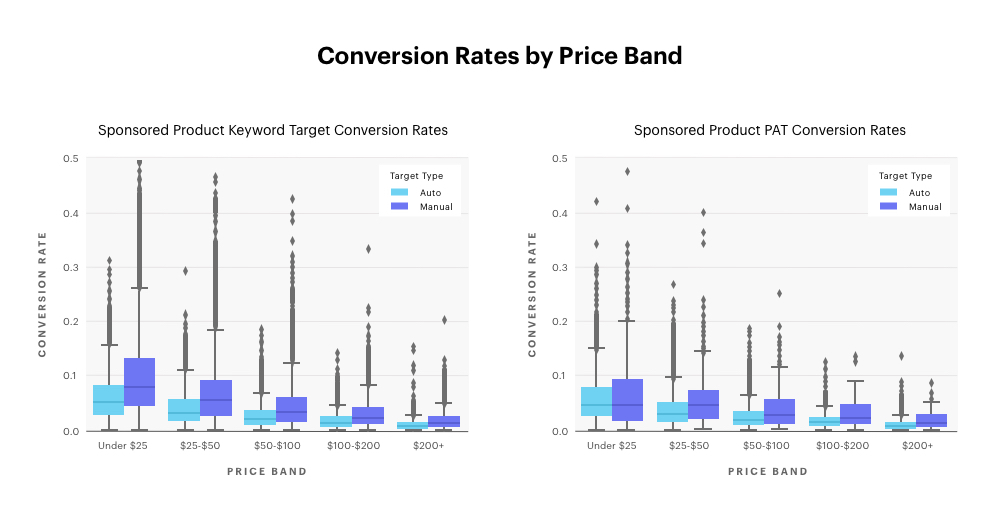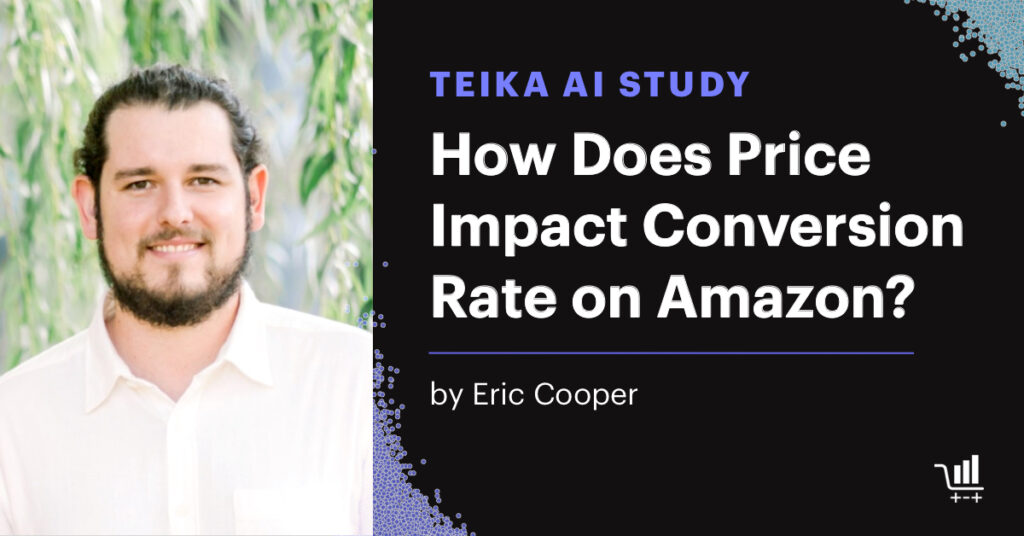Low prices are one of the many reasons consumers choose to shop on Amazon. But for brands selling on Amazon, price is one of just a few direct levers to help boost sales velocity, alongside advertising and other promotions. But what conversion rate can you expect with a lower price on Amazon? And how do those expectations change at higher prices? Teikametrics’ data science team tested this fundamental question. The results show that conversion rates for different classes of products are more price sensitive than others, and that whether an Amazon advertising campaign is automatically or manually targeted has a role to play as well.
Teikaways
- Always look to move high-performing search terms from automatic campaigns into manual campaigns in order to maximize your conversion rates. (Note: Teikametrics’ keyword recommendations automatically migrate keywords from auto to manual campaigns.)
- Remember that when selling at a lower price point, consumers can be more discriminatory based on price, whereas at a higher price point, other tactics (like reviews or product differentiators) can make a larger impact. (Note: Teikametrics unique incrementality testing process helps validate the effects of your price changes.)
- Segment keywords to better align the potential value of a click (and your corresponding bid) with the level of marketplace competitiveness. (Note: Teikametrics Campaign Creator allows you to quickly build out campaigns by Brand, Competitor, or Generic targeting strategies, with aggressiveness tailored to your product’s lifecycle and/or competitive environment.)
The black line in the below graphs highlight the expected conversion rate of a typical ad group based on observed data, mapped to the average (i.e. mean) price of products within that group. Within the graphs, you’ll see that the analysis is further split out between automatic campaigns and manual advertising campaigns.

Findings on Price & Conversion Rates
The analysis finds that there is an inverse relationship between an item’s price point and the conversion rate you should expect. Higher-priced items tend to see lower expected conversion rates, while lower-priced items tend to see higher expected conversion rates, with the relationship holding true across automatic and manual campaigns. This aligns with consumer behavior in general. Products costing hundreds of dollars (e.g. appliances, laptops) are naturally higher consideration items and consumers are less apt to convert after a click, potentially to look at a few options before deciding to purchase.
One important note – because this analysis did not examine individual items’ price changes, and hence price elasticity’s impact on conversion rate, you shouldn’t take this analysis as justification that a price cut will immediately lead to a conversion rate increase.
However, within individual price bands this analysis shows varying conversion rate ranges. There is a decided wider variance in conversion rate for lower-priced products, while most high-priced products see a low conversion rate with not as much variance. Remember that because conversion rates for those higher-priced items are lower in aggregate, the maximum observed conversion rate is lower, which naturally leads to a lower variance within the range itself.

Campaign Type Matters
The above graphs also emphasize that manual campaigns have more upside than automatic campaigns. Across campaigns optimized by Teikametrics, manually targeted campaigns drive a higher conversion rate than auto-targeted campaigns irrespective of price.
A search term that is producing conversions within an automatic campaign for a given product stands to drive even higher conversion rates once it is moved as a keyword to a dedicated manual campaign for that same product. This is the reason why, at Teikametrics, we actively surface keyword recommendations to support auto-to-manual campaign structures. Just remember that within this auto-to-manual structure, you should have at least one brand, generic, and competitor ad group to split keywords based on their relative incremental value. Flywheel Campaign Creator painlessly builds campaigns mapped to these audiences, which helps you better allocate spend, track performance, and optimize campaigns at a more granular level.
For lower-priced items, this analysis shows that price differences are associated with larger shifts in expected conversion rates at that price point. However, it also demonstrates the complex challenge for businesses operating at higher price tiers.
For items costing $100 or more, price differences don’t correspond as strongly to a conversion rate impact – either positively or negatively. This means brands with products in these upper bands should absolutely consider defending their price.
In these categories you can alternatively focus on maximizing your visibility (e.g. ads and organic rank) and branding in order to drive volume, since conversion rate remains relatively inelastic due to tactical price changes. Running a successful business at a high price point requires mastering the customer journey and marketing to it, a great customer experience to drive reviews and recommendations, and ideally a defendable moat or competitive advantage to put you in the best position vis a vis your competitors.
Driving sales velocity is a key goal when it comes to Amazon advertising. The more sales you drive, even via ads, the higher you rank organically on related terms. A better organic rank allows you to progressively spend less on advertising to drive the same level of sales, or allows you to reallocate that budget towards other growth areas.
Final Thoughts
Regardless of price point, no single change will sustain amazing conversion rates without having a good customer experience and optimized marketing to support the customer journey. The latter point is why, at Teikametrics, we work with our clients to implement strategic best practices like auto-to-manual campaign structures, bidding to value, and bid automation. Our unique capability to analyze incremental lift demonstrates to our clients how practices like these help Amazon businesses sustain success beyond a one-time price change.
If you’d like to talk with Teikametrics about our capabilities and tools around testing the incrementality of your Amazon advertising, schedule a time to talk to us.
Methodology
This analysis focused on Amazon Sponsored Product ads, utilizing two-years’ worth of data from across the Teikametrics customer set spanning 2018 through 2020. This large data set helps minimize keyword-specific peculiarities in conversion rate that may have occurred over a small period of time.
The Teikametrics data science team utilized a generalized linear model (GLM), a special type of linear regression, to determine the extent of a relationship between product price and conversion rate.





